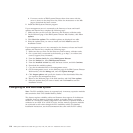
Toggling partitions by using the IMM Telnet interface
Note: Before you toggle a partition to Standalone mode, make sure that all the
nodes in the partition are powered off.
A partition can be in either of two modes: Standalone and Partition. When the
partition is in Standalone mode, each node operates independently. When the
partition is in Partition mode, all the nodes in the partition boot as a single system.
The command to toggle the partition is scale -mode standalone|partition
-partid id.
For example, to set partition 1 in Standalone mode, type scale -mode standalone
-partid 1.
Starting, stopping, and resetting by using the IMM Telnet
interface
There are three additional partition commands that you can use with the IMM
Telnet interface: start, stop, and reset.
You can use the start command (scale -start {-partid id | -node nodeid})to
start a partition or node. When you use this command, if the node is in a partition
and the partition is not in Standalone mode, all the nodes in the partition will
power on. For example, to start partition 1, type scale -start -partid 1.
Use the reset command (scale -reset {-partid id | -node nodeid}) to reset a
partition or node. When you use this command, if the node is in a partition and
the partition is not in Standalone mode, all the nodes in the partition will be reset.
Use the stop command (scale -stop {-partid id | -node nodeid}) to shut down
a partition or node. When you use this command, if the node is in a partition and
the partition is in Standalone mode, all the nodes in the partition will power off.
For example, to stop node 8bb9, type scale -stop -node 8bb9.
Configuring a QPI multi-node system
A multi-node configuration interconnects multiple servers or multiple partitions.
This configuration requires 8 microprocessors and 16 memory cards (4
microprocessors and 8 memory cards per node). See the documentation that came
with your QPI cables to set up your QPI multi-node configuration.
Before you create scalable partitions, make sure that all the nodes in the
multi-node configuration contain the following software and hardware:
v The current level of UEFI code, SAS UEFI code, IMM firmware, and FPGA
firmware
Note: To check for the latest firmware levels and to download firmware
updates, go to http://www.ibm.com/supportportal/.
v Microprocessor that are the same cache size and type, and the same clock speed
Note: The nodes can vary in the number of microprocessors and the amount of
memory each contains, above the minimum.
116 IBM System x3850 X5 and x3950 X5 Types 7145, 7146, 7143, and 7191: Installation and User's Guide


















